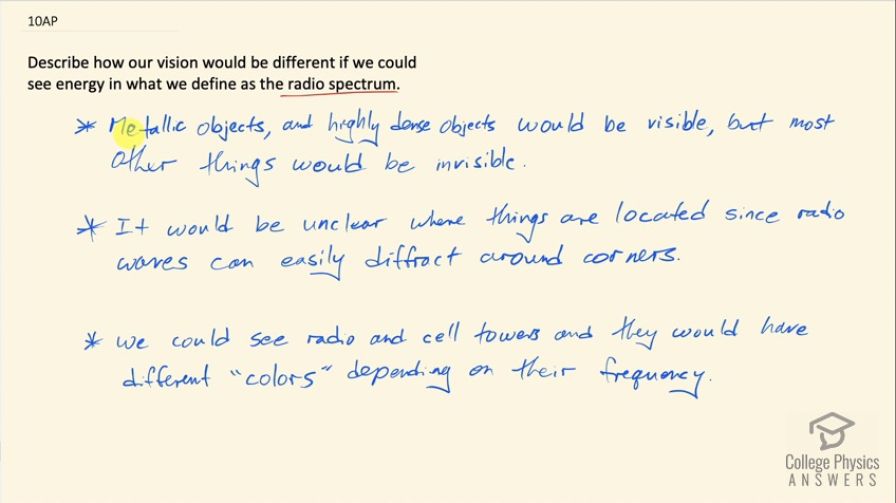Question
Describe how our vision would be different if we could see energy in what we define as the radio spectrum.
Final Answer
Please see the solution video.
Solution video
OpenStax College Physics for AP® Courses, Chapter 24, Problem 10 (Test Prep for AP® Courses)

vote with a rating of
votes with an average rating of
.
Video Transcript
This is College Physics Answers with Shaun Dychko. Our vision would be very different if we were to see in the radio spectrum; one thing that would be interesting is that metallic objects are things that we could still see and maybe highly dense objects as well but most other things would be invisible because you can only see what the light interacts with. So radiowaves easily go through windows, they go through walls, they would go through a desk and so if the radio waves don't interact with these things and don't bounce off of them, you won't see them, the only reason you see anything except for a light bulb is because light is bouncing off the things so visible light bounces off everything that you see with the exception of things that are producing the light such a bulb. But there would be radio bulbs so to speak because radio and cell phone towers do transmit and produce radiowaves and we would see those and they might have different colors depending on their frequency you know different radio towers will be AM or FM and cell phone towers are another frequency yet again. Another querky thing about seeing in the radio spectrum is that it would be unclear where things are positioned because radio waves can easily defract around corners. So if your eye is seeing something— this is your eye— and here's a corner of a wall and there's some object over here it's possible that radio waves— let's suppose it's a metal box— a radio wave could bounce off of it and then when it gets to this corner, it will defract around the corner so if we were to draw the wave fronts of this radio wave, there's a phenomenon of diffraction where this wave can bend around this corner and then you would perceive this radio wave but you wouldn't know where the metal box is because when you see something, you project straight along the ray of light and your imagined position for this box would be here. Now fortunately visible light is such high frequency and short wavelength that it does not defract around corners much and that's why our projection in the straight line is very accurate for visible light but it would not be accurate anymore with diffracting radio waves. Okay!